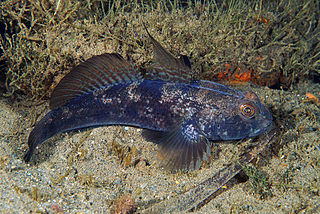
Gobiidae or gobies is a family of bony fish in the order Gobiiformes, one of the largest fish families comprising more than 2,000 species in more than 200 genera. Most of gobiid fish are relatively small, typically less than 10 cm (3.9 in) in length, and the family includes some of the smallest vertebrates in the world, such as Trimmatom nanus and Pandaka pygmaea, Trimmatom nanus are under 1 cm long when fully grown, then Pandaka pygmaea standard length are 9 mm (0.35 in), maximum known standard length are 11 mm (0.43 in). Some large gobies can reach over 30 cm (0.98 ft) in length, but that is exceptional. Generally, they are benthic or bottom-dwellers. Although few are important as food fish for humans, they are of great significance as prey species for other commercially important fish such as cod, haddock, sea bass and flatfish. Several gobiids are also of interest as aquarium fish, such as the dartfish of the genus Ptereleotris. Phylogenetic relationships of gobiids have been studied using molecular data.
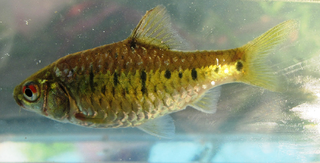
Barbodes semifasciolatus, the Chinese barb, is a species of cyprinid fish native to the Red River basin in southeast Asia where they occur in fresh waters at depths of 5 metres (16 ft) or less. The captive variant popularly known as the gold barb or Schuberti barb is an extremely popular aquarium fish.
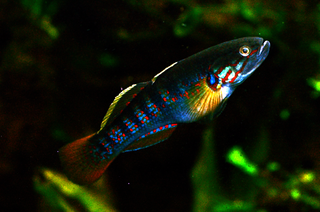
Eleotridae is a family of fish commonly known as sleeper gobies, with about 34 genera and 180 species. Most species are found in the tropical Indo-Pacific region, but there are also species in subtropical and temperate regions, warmer parts of the Americas and near the Atlantic coast in Africa. While many eleotrids pass through a planktonic stage in the sea and some spend their entire lives in the sea; as adults, the majority live in freshwater streams and brackish water. One of its genera, Caecieleotris, is troglobitic. They are especially important as predators in the freshwater stream ecosystems on oceanic islands such as New Zealand and Hawaii that otherwise lack the predatory fish families typical of nearby continents, such as catfish. Anatomically, they are similar to the gobies (Gobiidae), though unlike the majority of gobies, they do not have a pelvic sucker.

Fishkeeping is a popular hobby, practiced by aquarists, concerned with keeping fish in a home aquarium or garden pond. It is a practice that encompasses the art of maintaining one's own aquatic ecosystem, featuring a lot of variety with various water systems, all of which have their own unique features and requirements. Fishkeeping primarily serves as a token of appreciation and fascination for marine life and the environment that surrounds such, along with other purposes such as the piscicultural fishkeeping industry, serving as a branch of agriculture, being one of the most widespread methods of cultivating fish for commercial profit.

The freshwater butterflyfish or African butterflyfish is a species of osteoglossiform fish native to freshwater habitats in the Niger and Congo basins of western and central Africa. It is the only extant species in the family Pantodontidae. It is not closely related to saltwater butterflyfishes.
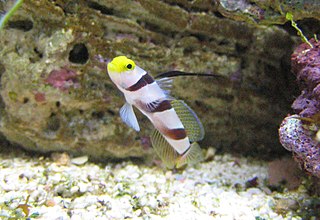
Stonogobiops nematodes, the Filament-finned prawn-goby, the Antenna goby, the high-fin goby, the red-banded goby, the high-fin red-banded goby, the striped goby, the barber-pole goby, or the black-ray Goby, is a species of marine goby native to the Indian Ocean and western Pacific Ocean from the Seychelles to the Philippines and Bali.

The redfin bully is a species of freshwater fish in the family Eleotridae endemic to New Zealand. Being amphidromous, it spends part of its life cycle at sea. Males have distinctive bright red patterns and stripes on their fins. Adults grow to an average of 80–100 mm (3.1–3.9 in) total length, with a maximum of 120 mm (4.7 in).

The Australian smelt is a small, pelagic silvery freshwater fish found in large numbers in waters of the south eastern Australian mainland.

Glossogobius is a genus of gobies native to fresh, brackish and marine waters from Africa to the coasts of the western Pacific Ocean. They are found in Madagascar, South Africa, Japan, Thailand, Australia, Indonesia, Bangladesh, the Philippines, Taiwan, Papua New Guinea, Singapore, Malawi, Eswatini, Botswana, Kenya, Zimbabwe, Tanzania, Mozambique, the Solomon Islands, Palau, Fiji, New Caledonia, India, Laos, Sri Lanka, Myanmar, Borneo, Nepal, Brunei Darussalam, Micronesia, Cambodia, Vietnam, China, Réunion, the Seychelles, Mauritius, the Caroline Islands, Vanuatu, Malaysia and Russia. The genus also includes a troglobitic species, G. ankaranensis.

The Hawaiian freshwater goby, or ʻOʻopu, is a species of goby endemic to Hawaii, commonly located in freshwater mountain streams in higher elevations.
Sicyopterus lagocephalus, the red-tailed goby or blue stream goby, is a species of goby native to islands of the Indian Ocean from the Comoros to the Mascarene Islands to the Pacific Ocean where it reaches French Polynesia and can be found as far north as Japan. It is an amphidromous species: adults can be found in swift-flowing streams with rocky beds but the eggs hatch at sea and the larval stage remains in marine waters, migrating to freshwaters when they reach the postlarval stage. This species can reach a total length of 13 cm (5 in). In some places it is an important species for local consumption with the post-larvae being caught as they mass in estuaries.

The violet goby is a species of goby native to marine, fresh and brackish waters near the Atlantic coast of North and South America from South Carolina in the United States of America, to northern Brazil. It prefers bays, estuaries and river mouths with muddy substrates. It is often marketed as the dragon goby or dragon fish.

Stigmatogobius sadanundio is a species of goby native to south Asia from India to Indonesia including Sri Lanka and the Andaman Islands. It can be found in mostly fresh waters of estuaries and the tidal zones of rivers. It can also be found in the aquarium trade, where it is often marketed as the knight goby.

Coastal fish, also called inshore fish or neritic fish, inhabit the sea between the shoreline and the edge of the continental shelf. Since the continental shelf is usually less than 200 metres (660 ft) deep, it follows that pelagic coastal fish are generally epipelagic fish, inhabiting the sunlit epipelagic zone. Coastal fish can be contrasted with oceanic fish or offshore fish, which inhabit the deep seas beyond the continental shelves.

Gymnothorax polyuranodon, commonly known as the freshwater moray, is a species of moray eel that is native to the Indo-Pacific region, including Sri Lanka, the Philippines, Indonesia, Papua New Guinea, the northern coastline of Australia, and various islands in the western Pacific. Other common names include the many-toothed moray, spotted freshwater moray, blackspotted moray, freshwater leopard moray, and freshwater tiger moray.

The Indian mud moray eel, is a moray eel found in the western Pacific and Indian Oceans. It was first named by Hamilton in 1822, and is also commonly known as the freshwater moray or freshwater snowflake eel.

Oxyurichthys microlepis, commonly known as the maned goby, is a species of goby native to tropical marine and brackish waters along the coasts of the Indian Ocean from Africa to the western Pacific Ocean where it occurs in estuaries and inshore waters to depths of about 75 metres (246 ft). It occurs in the Mekong Delta and is suspected to use the tidal flow up the river to reach as far inland as Cambodia. This species can reach a length of 13.5 centimetres (5.3 in) TL. It is of minor importance to local commercial fisheries and can also be found in the aquarium trade.

True gobies were a subfamily, the Gobiinae, of the goby family Gobiidae, although the 5th edition of the Fishes of the World does not subdivide the Gobiidae into subfamilies. They are found in all oceans and a few rivers and lakes, but most live in warm waters. Altogether, the Gobiinae unite about 1149 described species in 160 genera, and new ones are still being discovered in numbers.
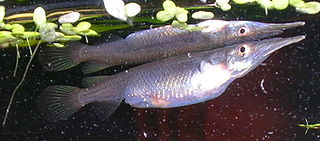
Zenarchopteridae, the viviparous halfbeaks, is a family in the order Beloniformes. The Zenarchopteridae exhibit strong sexual dimorphism, practicing internal fertilisation, and in some cases ovoviviparous or viviparous. The members in the family are mainly found in fresh and brackish water of tropical Asia and New Guinea, but the genus Zenarchopterus also includes marine species from the Indo-Pacific. Several, such as the wrestling halfbeak, have become commonly traded aquarium fish.

The frillfin goby is a species of marine fish in the genus Bathygobius.























